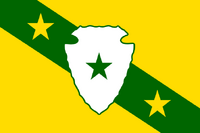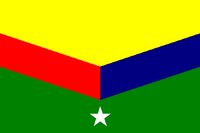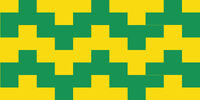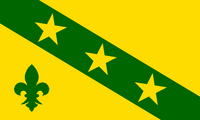| This page uses Creative Commons licensed content from Wikipedia. (view authors) |
The design for the flag of the state of North Dakota is an almost exact copy of the unit banner carried by the state's troop contingent in the Philippine-American War. It was adopted by the North Dakota Legislative Assembly on March 3, 1911, although the color was not precisely specified at that time. Legislation in 1943 brought the flag in line with the original troop banner, which is on display at the North Dakota Heritage Center in Bismarck. The flag also resembles the Great Seal of the United States.
Coat of arms

State coat of arms
| This page uses Creative Commons licensed content from Wikipedia. (view authors) |
Section 54-41-01 of the North Dakota Century Code specifies the design (blazon) of the coat of arms thus:
- Device: On an Indian arrowhead point to base Or a bend vert charged with three mullets of the first, in base a fleur-de-lis of the second.
- Crest: On a wreath Or and azure, a sheaf of three arrows argent armed and flighted gules behind a stringed bow fessways Or with grip of the second (gules).
- Motto: Strength from the soil.
The allusions made in the arms are laid down in section 54-41-02 NDCC:
- "The colors of yellow, gold and green are indicative of the great agricultural state of North Dakota and has particular reference to ripening grain and the abundant grazing areas. The Indian arrowhead forms the shield of the coat of arms and symbolizes the "Sioux State." The three stars denote the trinity of government; legislative, executive, and judicial. Each star in the bend is given the heraldic value of thirteen which signifies the thirteen original colonies of the United States, and the cumulative numerical value of the three stars indicates that North Dakota was the thirty-ninth state admitted to the Union. The stars also allude to the history of the territory under three foreign flags. Three stars are borne upon the coat of arms of Meriwether Lewis of the Lewis and Clark expedition and also on the coat of arms of Lord Selkirk, head of the first permanent settlement in this state. The fleur-de-lis alludes to La Vérendrye, a Canadian explorer who was the first known white man to visit the territory of this state. The blue and gold wreath in the crest reflects the history of the territory as part of the Louisiana purchase. The crest which shall constitute the military crest of the state of North Dakota is a motif taken from the state seal and to the Sioux Indian tribes signifies mighty warriors."
Proposals for a New Flag of North Dakota
North Dakota State Flag Proposal No. 7 Designed By: Stephen Richard Barlow 16 OCT 2014 at 1008hrs cst
North Dakota State Flag Proposal No. 8 Designed By: Stephen Richard Barlow 16 OCT 2014 at 1010hrs cst
North Dakota State Flag Proposal No. 9 Designed By: Stephen Richard Barlow 16 OCT 2014 at 1014hrs cst
North Dakota State Flag Proposal No. 10 Designed By: Stephen Richard Barlow 16 OCT 2014 at 1018hrs cst
North Dakota State Flag Proposal No. 11 Designed By: Stephen Richard Barlow 16 OCT 2014 at 1025hrs cst
North Dakota State Flag Proposal No. 12 Designed By: Stephen Richard Barlow 16 OCT 2014 at 1031hrs cst

























